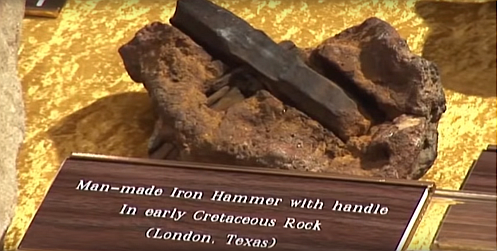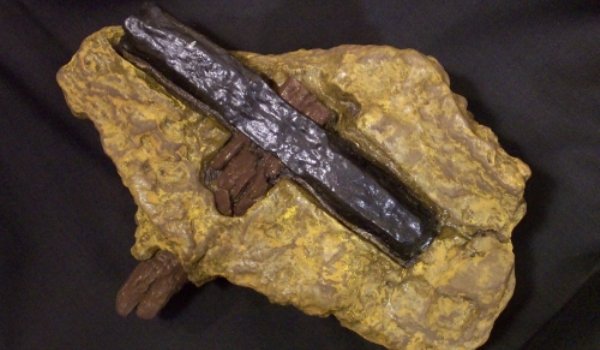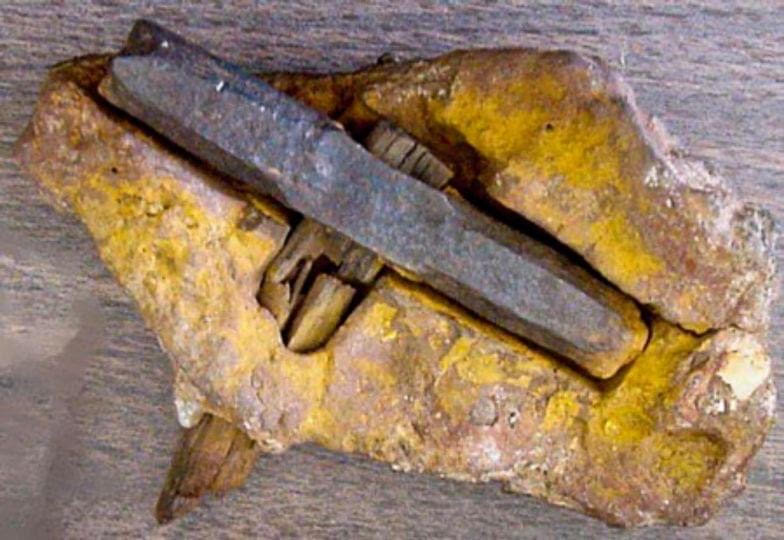The Mystery Of The Modern “London Hammer” Found Encased In Ancient Rock
The rock appeared to be ancient. The hammer inside it looked modern.
The London Hammer, discovered in 1936 in Texas, is a controversial out-of-place artifact that appears to be a 19th-century tool encased in rock purportedly dating to the Cretaceous period, sparking debate. This intriguing find challenges established geological timelines and has generated significant discussion regarding its origin and the processes that led to its encasement in rock supposedly millions of years old.
While walking along Red Creek, London, Texas in June 1936, Emma Zadie Hahn and her husband Max Edmond Hahn made an unusual discovery: a piece of wood poking out of what appeared to be an ancient rock formation.
The story goes that ten-ish years later, their son, who was clearly born with the merest hint of curiosity that they lacked, smashed open the rock to see what was inside. What he found was a hammer. Where it gets weirder is that it was clearly a modern(ish) hammer.
The hammer attracted the unhelpful attention of Young Earth Creationist Carl Baugh, who claimed that the rock around the hammer was from the Cretaceous period. This would mean that whoever dropped the hammer of 19th century design did so while (e.g.) running away from a triceratops.
For Baugh, who was himself incorrect, this was evidence that evolution theory was incorrect. and proof that the world is not an evolutiionary but a creationary design designed by one magnificant powerful and only One….. God!
“If the artifact is truly from the Cretaceous time frame, where does this leave evolutionary theory, since man was not supposed to have evolved for another 100-million years or so?” Baugh asked. “If the artifact is relatively recent, that means that the Cretaceous Hensell Sand formation from which it came is relatively young… Again, where does that leave evolutionary theory with its traditional dates for the Cretaceous formations?””
The answer, of course, was that the hammer was modern, but it had become encased in the rock by geological processes not known to Baugh.
“The stone is real, and it looks impressive to someone unfamiliar with geological processes. How could a modern artifact be stuck in Ordovician rock?” investigator Glen J. Kuban asked in a 1997 paper on the hammer, published in Paleo.
“The answer is that the concretion itself is not Ordovician. Minerals in solution can harden around an intrusive object dropped in a crack or simply left on the ground if the source rock (in this case, reportedly Ordovician) is chemically soluble.”
While an extremely cool find, the rock formation is not as ancient as it appeared. Likely a miner dropped the hammer a century ago, or perhaps a touch earlier, after which the rock formed around it. It was not, repeat, not, proof of The Flintstones. source
London Hammer: The artifact of 140 million years older than our civilization.
The hammer is identical to late 19th-century mining hammers, and the most likely explanation for its encasement in rock is that a deposit of highly soluble travertine formed and hardened around it within a relatively short time.
The hammer was purportedly found by a local couple, Max Hahn and a female friend, while out walking along the course of the Red Creek near the town of London. They spotted a curious piece of loose rock with a bit of wood embedded in it and took it home with them. A decade later, their son Max broke open the rock to find the concealed hammerhead within.
The metal hammerhead is approximately 6 inches (15 centimeters) long and has a diameter of 1 in (25 mm), leading some to suggest that this hammer was not used for large projects, but rather for fine work or soft metal. The metal of the hammerhead consists of 96.6% iron, 2.6% chlorine, and 0.74% sulfur.
The hammer began to attract wider attention after it was bought in 1983 by the creationist Carl Baugh, who claimed the artifact was a “monumental ‘pre-Flood’ discovery.” He has used it as the basis of speculation of how the atmospheric quality of an antediluvian earth could have encouraged the growth of giants. Baugh’s Creation Evidence Museum purchased the hammer around 1983 and began to promote it as “the London Artifact”.
Other observers have noted that the hammer is stylistically consistent with typical American tools manufactured in the region in the late 19th century. Its design is consistent with a miner’s hammer. One possible explanation for the rock containing the artifact is that the highly soluble minerals in the ancient limestone may have formed a concretion around the object via a common process (like that of a petrifying well) which often creates similar encrustations around fossils and other nuclei in a relatively short time.
References
- ^ Jump up to:a b c Cole, J. R. (Winter 1985). “If I Had a Hammer”. Creation Evolution Journal. 5 (15). National Center for Science Education Inc.: 46–47.
One of his principal pieces of evidence for human contemporaneity with supposedly ancient geological strata is an iron hammer with a wooden handle found near London, Texas by others in the 1930s in an “Ordovician” stone concretion…” (Baugh, 1983b).
- ^ Jump up to:a b c d Kuban, Glen J. (July 14, 2006). “The London Hammer: An Alleged Out-of-Place Artifact”. Glen Kuban’s Web Sites. Retrieved July 7, 2015.
An iron and wooden hammer, sometimes called the “London Artifact” or “London Hammer,” found by local hikers in a creek bed near London, Texas in 1936, has been promoted by Carl Baugh and other strict creationists as an out-of-place artifact. They maintain that the hammer, which was partially embedded in a small, limy rock concretion, originated in a Cretaceous rock formation (or an Ordovician or Silurian one, depending on the account), thus contradicting the standard geologic timetable. However, the hammer was not documented in situ and has not been reliably associated with any specific host formation. Other relatively recent implements have been found encased in by similar nodules and can form within centuries or even decades under proper conditions (Stromberg, 2004). The hammer in question was probably dropped or discarded by a local miner or craftsman within the last few hundred years, after which dissolved limy sediment hardened into a nodule around it.
- ^ Helfinstine, Robert F.; Roth, Jerry D. (2007). “Texas Tracks and Artifacts: Do Texas Fossils Indicate Coexistence of Men and Dinosaurs?”. R & J Pub.
- ^ “The London Artifact”. www.creationevidence.org. Retrieved February 25, 2015.
- ^ Middleton, Jim (July 20, 2011). “The London Hammer”. Historic Mysteries. Retrieved February 25, 2015.
First of all, there are conflicting reports as to where the object was actually located in the surrounding rocks. And there is no photographic evidence of the object prior to being disturbed. One report states that the hammer was embedded in a rock formation dating from the Cretaceaus Period (65-135 million years ago), whilst others stating from Ordovician strata. But other accounts state that Mr. Hahn found the hammer bearing nodule “near” these surrounding rocks, lying loose not in situ. Skeptics argue that minerals could have cemented the hammer around the Cretaceous rock after it was dropped or left behind. This could easily lead novice geologists to believe that the hammer and the rock formation are from the same time period. The only true method of determining the age of the hammer is through Carbon 14 dating of the wooden handle, but Baugh has yet to authorize this procedure. The handle appears to be partially fossilized, so this certainly adds to the argument that this a very ancient tool. But fossilization can occur prematurely through various natural methods. To skeptics, the hammer appears to be a tool that was abandoned or lost some 200 years ago, but to it’s [sic] supporters, this is a clear indication that man has been on this Earth much longer than previously thought.
- ^ Coppedge, M. “Giant Humans and Dinosaurs”. www.biblebelievers.org.au.
- ^ Keith Fitzpatrick-Matthews (May 9, 2007). “The London Artifact (Texas)”. Bad Archaeology. Retrieved December 17, 2016.



